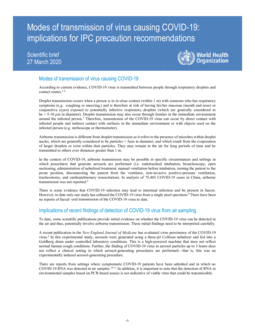Hello! You're looking at a policy document report on Overton
We track government policy, guidelines, think tank research, working papers and more to help our customers see the impact and influence of their work. Are you interested in seeing what information we have to offer? Request a free trial to our platform.
If you fund, produce or manage research or work to influence policy, we'd love to talk. Learn more on our homepage.

Modes of transmission of virus causing COVID-19: implications for IPC precaution recommendations: scientific brief, 27 March 2020
Topics in this document
Clinical medicine
Health care
Diseases and disorders
Coronavirus disease 2019
Infectious diseases
Microbiology
Epidemiology
Transmission (medicine)
Infection
Infection control
Public health
Health
Health sciences
Medical specialties
Medicine
Medical humanities
Airborne disease
Severe acute respiratory syndrome coronavirus 2
Coronavirus
Medical statistics
World Health Organization
Aerosol
Disease
Hygiene
Virus
Severe acute respiratory syndrome
Related SDGs
SDG 3: Good Health and Well-being ...
SDG 3: Good Health and Well-being
Target 3.3
End the epidemics of AIDS, tuberculosis, malaria and neglected tropical diseases and combat hepatitis, water-borne diseases and other communicable diseases
Target 3.d
Strengthen the capacity of all countries, in particular developing countries, for early warning, risk reduction and management of national and global health risk
Cites research funded by
1
NSF (Special project, May 2022)
1
Division of Intramural Research, National Institute of Allergy and Infectious Diseases
1
Defense Advanced Research Projects Agency
1
United States National Science Foundation
1
U.S. Department of Defense
2
National Institute of Allergy and Infectious Diseases
1
USAF 347 Contracting Squadron
1
National Science Foundation
1
NIH (Special project, May 2022)
1
Ministry of Science and Technology
1
National Natural Science Foundation of China
1
Health and Medical Research Fund
1
National High-tech Research and Development Program
1
National Institute on Minority Health and Health Disparities
Citations
Cited by 51
other policy documents
(45 of them are from other policy sources)
